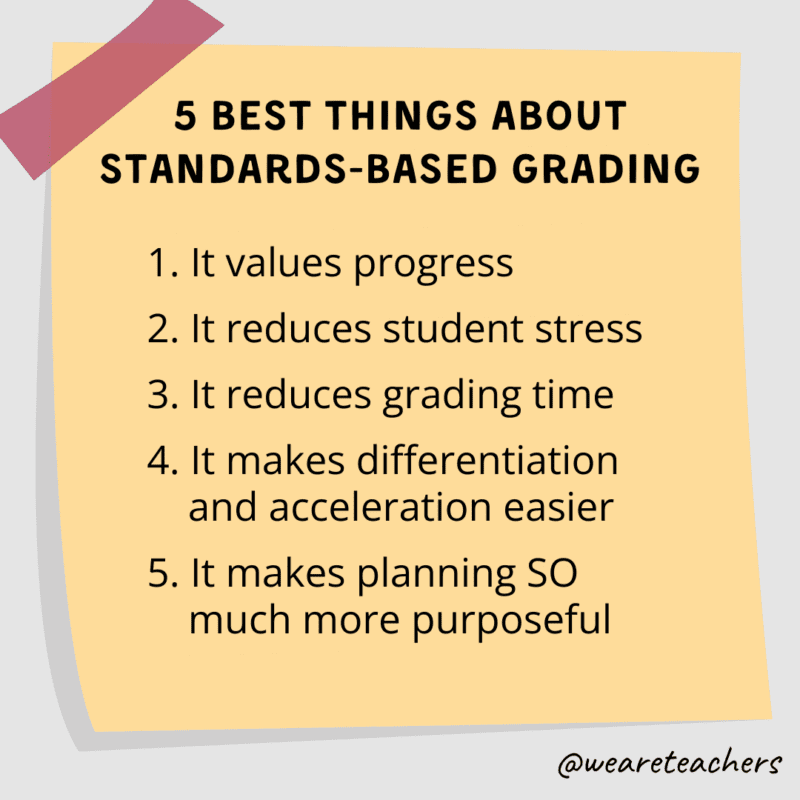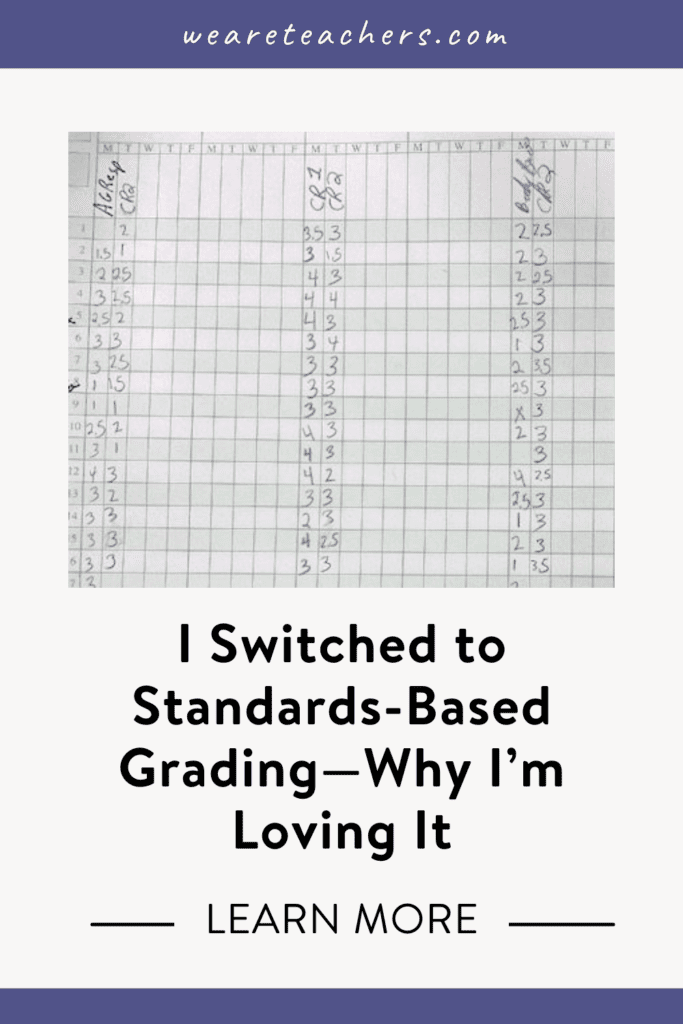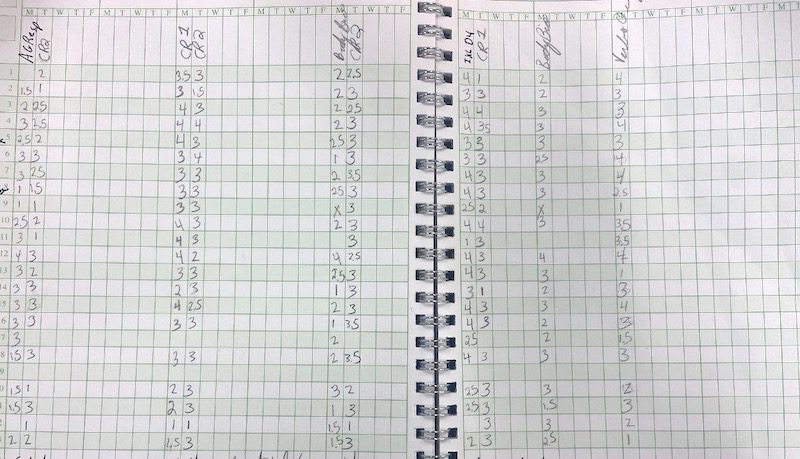This year I moved to a school that uses standards-based grading. If you don’t know what that is, don’t worry. I didn’t either until six months ago. Basically, standards-based grading means that students don’t receive a class average. Instead, they’re assessed on each standard you teach that term. At my school, grades range from a 1 (does not meet standards) to a 4 (exceeds standards), and report cards are six pages long because each subject has a couple of dozen standards.
I was anxious about standards-based grading, but now I’m in love. It’s changed not only the way I grade but the way I teach, and my completely objective opinion is that every single school in the country should use this system. Here’s why.
1. Standards-based grading values progress
If your grading system averages together students’ grades from the beginning of the semester to the end, you’re giving equal weight to early assessments that might not reflect the knowledge and skills they gain over the semester.
My students wrote multiple persuasive pieces over the course of the semester, and I had a huge number of kids who started at a level one and progressed to a three or even a four. In traditional grading, I’d average those scores together, and their final grade would say that they still hadn’t mastered the skill. Instead, I could choose their highest assessment score on that skill and let their families know what level they’ve reached after lots of practice.
2. It reduces student stress
Kids know exactly what they need to do to succeed, and they know they’ll get multiple opportunities to practice and to demonstrate mastery. For example, I recently gave a test over types of verbs to my sixth grade language arts students. The ones who didn’t pass came to a review session and took it again. But some kids, even though I know they’re capable, still didn’t pass. Test anxiety is a huge problem for a lot of kids, and it makes it harder for them to show what they’ve learned.
With standards-based grading, I could say, “Okay, do this lesson in IXL and prove to me that you know how to tell the difference between types of verbs.” Once students did that, they’d shown mastery of the standard and didn’t have to worry about the test grade. Knowing what the criteria is and knowing that they can keep trying to meet them has helped my students to stay motivated and not shut down after a low grade.
[contextly_auto_sidebar]
3. It reduces grading time
At my previous school, we had to enter two grades a week for each class. That meant two assessments for each kid, which meant that they were often basic, surface-level, easily graded assignments that didn’t provide a lot of depth or creativity. It also meant a huge amount of time spent chasing down missing work and helping students organize a large number of worksheets or Google Classroom assignments.
Now, I generally have one assignment every week or two. Students spend several days working on it and editing their work, and each assessment covers a few of the standards we’re learning about. A protest song analysis next week will assess their ability to identify theme, use textual support to back up a statement, organize their thoughts in a paragraph, and edit their work.
This gives kids more time to focus on a complex and engaging assignment, which allows me time to conference with them during the process. Then, when they’re done, I’m able to go over with them exactly which standards they’re meeting and which ones need work. Then we can make a plan; should they redo part of the assignment to reflect new understanding, or wait until another opportunity to show me that particular skill?
4. It makes differentiation and acceleration easier
Maybe some teachers are able to look at their grade book and tell which kids have mastered a particular skill and which ones haven’t, but I was never able to do that until I started using standards-based grading. With all my grades organized by standard, it’s easy to see which students need more scaffolding and which kids are ready for a new challenge.
When we read nonfiction text, we do it in three levels now. Students who consistently score a four on nonfiction assignments write a complex summary and analysis, often in groups, so they have extra support. Students who are on level respond in writing to a grade-level question. And students who generally score in the one-two range work in a group with me to make sure they understand the reading and how to respond.
The best part is that these groups are completely flexible based on the standard. My teacher-support nonfiction kids might be accelerated poets or public speakers. Standards-based grading helps me assess what kids actually need, not just sort them into “low” and “high.”
5. It makes planning SO much more purposeful
I’ve got six standards I’m focusing on this nine weeks. I still use a paper grade book because I’m old school, and I organize it by standard at the beginning of the quarter. As I plan, I know exactly what I want my students to be able to do in March, so backward design is much more intuitive than it used to be. I’m always focused on the end goals, so as I make weekly plans, I’m asking questions like, “Do kids need more practice analyzing character, or have they mastered that?” “Have I given enough opportunities for kids to make inferences and defend them?”
It’s much more meaningful than, “What’s a fun project to do with The Giver?” or “What can I assign for homework on Tuesday?” It’s easy to explain the purpose of assignments to students, too, and eliminates a lot of the busywork that makes school such a frustrating experience for so many kids (and teachers)!
Standards-based grading was intimidating to me at first, and I still haven’t totally figured it out. It requires a little more organization and a major shift in thinking. But I do know that it’s been better for me and for my students, and I don’t think I can ever go back to traditional grading.

What are your thoughts on standards-based grading? Share in the comments below! Plus, check out why we love this TikTok teacher’s policy for grading homework.
Want more articles like this? Make sure to subscribe to our newsletters.


